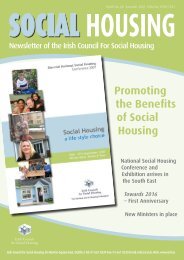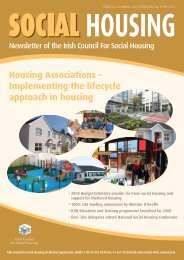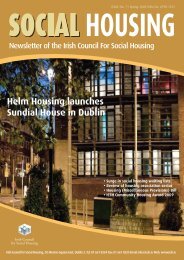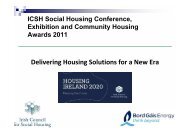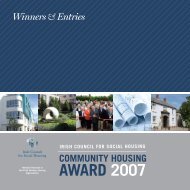National Housing Strategy for People with a Disability 2011 - 2016
National Housing Strategy for People with a Disability 2011 - 2016
National Housing Strategy for People with a Disability 2011 - 2016
You also want an ePaper? Increase the reach of your titles
YUMPU automatically turns print PDFs into web optimized ePapers that Google loves.
Case Study – Jimmy’s Story10.23 The movement of people <strong>with</strong> intellectual disabilities from institutions to communitybased living could involve a range of possibilities such as shared accommodation, adultfostering, private rented accommodation, supported living, etc. The following case studytells Jimmy’s story and his experiences of more independent living in the community 113 .Case Study 11.1: Jimmy’s StoryJimmy is a 31-year old man who has Down Syndrome. He has a hearing difficulty andepilepsy. He lived <strong>for</strong> 16 years in a congregated setting catering <strong>for</strong> 28 men and women.He moved to a group home in 2000 to live <strong>with</strong> 4 other young men of similar ability andsupport needs. One staff member was required at all times to support the 5 men, <strong>with</strong> a‘sleep over’ in place at night.Once Jimmy settled into his new home, he learned to travel independently to work and touse all community facilities and services. He enjoyed his freedom and independence andindicated in 2007 that he didn’t want to live in a staffed home any longer. He chose tomove <strong>with</strong> another young man to a tenancy arrangement in a house in the locality. Soonhis other two friends decided to join him. All four get the individual support they need intheir new arrangement. This move brought challenges <strong>for</strong> Jimmy and <strong>for</strong> his family. Hisfamily adjusted slowly to the fact that they no longer controlled Jimmy’s money, that heoperated a post office account independently, and that he made decisions aroundbudgeting. They worry about his vulnerability <strong>with</strong> his money. Jimmy is learning theimportance of making the right decisions about money – to plan, not to borrow, and to pay<strong>for</strong> all his needs.Jimmy is adjusting to living as an equal member of a small group of people sharing atenancy. He is learning the importance of respecting other people’s space, others’property. He continues to adjust to his role and responsibilities in the community and islearning to manage the consequences of his occasional untoward behaviour. His newfoundskills have helped him to get work opportunities. Jimmy has learned to manage his healthand his medication, and responds positively to technologies in his home to help managehis epilepsy. His relationship <strong>with</strong> his family, from their point of view, has changeddramatically. He is no longer dependent on them, he prefers to spend his weekends <strong>with</strong>his friends and participating in local activities, his visits home are shorter and he prefers toact independently of family. Jimmy’s family found it hard to adjust to his newfoundindependence and his need to be his own person. Staff met opposition to new ideas andnew ways of supporting Jimmy to meet his goals and outcomes. A lot of time was spent113Report of the Working Group on Congregated Settings, HSE (June <strong>2011</strong>)134



